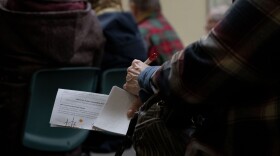When it comes to investing in energy efficiency, many in New Hampshire’s clean energy sector are worried the state is falling behind the rest of the region. A recent national report seems to bear that out. It ranks New Hampshire last in New England for efficiency policies. But efforts to ramp up the least controversial energy policy – using less – could have a hard time getting the support of the state’s business community.
When the results of a state-commissioned study on energy efficiency came out recently, its findings weren’t surprising to people watching the Granite State’s policies. One of its central findings was that “New Hampshire could cost effectively be doing 10 times more energy efficiency than it is now,” explains Natalie, an efficiency advocate with the Northeast Energy Efficiency Partnerships (NEEP). Treat, and many others who look at energy policy, argue that New Hampshire should do more.
The standard argument for this is pretty simple: every year homeowners, businesses and institutions in the state spend about $6 billion dollars on fuel and electricity; $3.9 billion, that’s 65 percent, of those dollars go out of state immediately. Saving that money would mean more of it sloshing around generally in the New Hampshire economy.
“Big Price Tags”
The problem is you have to spend up front in order to capture the savings down the road, which makes some interests leery.
“There’s a lot of interesting things in that study, there’s a lot of big price tags in that study also,” says Mike Licata vice president of the state’s biggest business lobbying group, the BIA.
The big price tags would go incentives to coax more homeowners to insulate and tighten up their homes and switch to more efficient light bulbs and refrigerators, and more businesses to install furnaces and industrial equipment. Right now the programs that subsidize energy efficiency work are paid for mostly by tiny amounts siphoned off electric bills – .3 cents a kilowatt hour or about two dollars a month for the average customer.
For a family that uses just a little electricity that’s no big deal, but a big chunk of businesses’ expenses go toward electricity and they are very keen on keeping energy prices low.
“I think one of the recommendations is to increase the funding by roughly $93 million over five years,” says Licata, “I guess the short answer there is that seems to not quite strike the right balance in our perspective.”
But just over the southern border the business community has been persuaded.
In part, Bay State businesses were persuaded by a key phrase. A Massachusetts law – the green communities act passed in 2008 – says money taken from electric bills will go towards achieving “all cost effective” energy improvements.
“I think for the business community that’s a very important piece in all of this,” says Mark Silvia, Commissioner of the Massachusetts Department of Energy Resources, “If there are going to be programs they can take advantage of, there have to be more benefits than there are costs.”
That support has been crucial for making Massachusetts the national leader for its energy efficiency programs, and the same language is being bandied about by New Hampshire’s Energy Efficiency and Sustainable Energy (EESE) Board. Because of this language Massachusetts utilities aggressively pursue chances to conserve energy, whereas in New Hampshire utilities get a modest sum of money and they mostly wait for consumers to come to them.
Time to Decouple?
To get anywhere near to what Massachusetts does, New Hampshire has a few hurdles to clear.
One is that N.H. utilities still make money per unit of electricity or gas sold, so investing in efficiency means less revenue. They have very little incentive to get aggressive about efficiency. Breaking this relationship is called decoupling, and about a dozen states have done this in some way.
Recently the EESE board, which has representatives from the utilities, voted to ask regulators at the Public Utilities commission to start conversations about how to get those incentives in line and start setting more ambitious efficiency goals.
“We can’t actually ramp up our programs until we’re directed to and part of that discussion at the PUC is all about the revenues and rate-impacts and how the program works,” says Kate Peters, director of Public Service of New Hampshire’s efficiency programs.
Crisis of Confidence
But while that gets hashed out, there’s a higher hurdle, one of trust especially for businesses in New Hampshire.
After years of seeing the funds that were supposed to be set aside for energy efficiency repeatedly pillaged by legislators looking to balance the budget businesses aren’t excited about making those pots of money any bigger.
The BIA actually supports efficiency spending in concept.
“It’s one thing to say ok, let’s spend $93 million dollars on energy efficiency. It’s another to say ok let’s create a pot of money to spend $93 million on energy efficiency and then what happens when the state gets into another budget crunch,” says Licata Which invariably we’ll be back there in about a year I’m quite sure.”
So energy efficiency boosters are looking at something of an impasse. Even though they point out that without reducing consumption, New England will have to build ever more power infrastructure: be it wind turbines, gas pipelines, or nuclear plants. All of that will be expensive in its own right.
“It costs about a third as much to meet those capacity needs through energy efficiency as through new supply,” says Natalie Treat of NEEP, “On the fuel side of things its 9 to ten cents a kilowatt hour for new electric supply and looking at about 3 cents a kilowatt hour for a portfolio of energy efficiency savings.”
But Energy fights over wind energy, power lines, and the state’s energy plan are all teed up to take place in Concord this year. So it’s an open question whether meaningful movement on energy efficiency policy will simply get lost in the noise.









